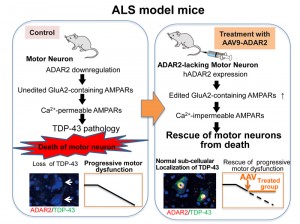A major step towards the cure of sporadic ALS Experimental gene therapy for a sporadic ALS mouse model

Amyotrophic lateral sclerosis (ALS) develops mainly in the middle-aged and elderly and is characterized by progressive muscular weakness and muscular atrophy. There is no known cure for this incurable neurological disease, which leads to death due to paralysis of the respiratory muscles within a few years of onset. The research group of Project Professor Shin Kwak (Visiting Researcher, Clinical Biotechnology Laboratory, Center for Disease Biology and Integrative Medicine, Graduate School of Medicine, the University of Tokyo; Project Professor, Clinical Research Center for Medicine, International University of Health and Welfare) had discovered in earlier research that the enzyme ADAR2 was involved in neuron cell death in non-familial ALS, which accounts for the great majority of cases of the disease.

© teamkwak, A single intravenous injection of AAV9 vector successfully delivered the human ADAR2 (RNA editing enzyme) gene to motor neurons of AR2 mice, in which the ADAR2 gene was ablated selectively in the motor neurons, therefore comprising a mechanistic mouse model of sporadic ALS. The resulting expression of ADAR2 effectively rescued progressive motor dysfunction and death of motor neurons in the AR2 mice.
In this study, Project Professor Kwak and Project Researcher Takenari Yamashita (Clinical Biotechnology Laboratory, Center for Disease Biology and Integrative Medicine, Graduate School of Medicine, the University of Tokyo), in collaboration with Special Professor Shinichi Muramatsu’s research group (Jichi Medical University), developed an adeno-associated virus serotype 9 (AAV9) vector that would enable gene delivery only to the neurons of mouse brain and spinal cord. When this vector was administered by intravenous injection into the sporadic ALS model mice (AR2), the researchers succeeded for the first time in stopping the degeneration and loss of motor neurons and the progression of symptoms of the disease.
Further, even when administered after the emergence of symptoms, expression of the ADAR2 gene in motor neurons stopped the process leading to cell death and symptoms due to cell death were prevented without any apparent side-effects. It is conventionally thought that it is difficult to introduce genetic material into the brain and spinal cord by intravenous injection, but one intravenous injection alone was sufficient to bring about long-lasting expression of an effective quantity of the ADAR2 gene through the use of the AAV9 vector to trigger gene expression only in neurons.
While this result was achieved with a model mouse, it is thought that a similar molecular mechanism underlies sporadic ALS in human patients, and as human ADAR2 gene had a therapeutic effect in the model mouse, it is anticipated that a similar form of gene therapy will be effective in treating human ALS as well. Further, the AAV9 vector is known to be safe, and after confirming the safety of the improved AAV9 vector and determining optimal dosage, it is hoped that this research will open a new route to the treatment of ALS. Currently gene therapy has a strong image as a replacement therapy for rare genetic disorders, but this research is unique in that it shows that gene therapy is possible even in sporadic cases if the molecular pathology of the disease is understood.
This research was published in EMBO Molecular Medicine (24 September 2013 online edition). The present study was conducted with the support of the Japan Science and Technology Agency Strategic Basic Research Programs (CREST) and the Ministry of Health, Labour and Welfare Illness-related Disabilities Measures Research Program.
Press release [PDF] (Japanese)
Paper
Takenari Yamashita, Hui Lin Chai, Sayaka Teramoto, Shoji Tsuji, Kuniko Shimazaki, Shin-ichi Muramatsu and Shin Kwak,
“Rescue of amyotrophic lateral sclerosis phenotype in a mouse model by intravenous AAV9-ADAR2 delivery to motor neurons”,
EMBO Molecular Medicine Online Edition: 2013/9/24 (Japan time), doi: 10.1002/emmm.201302935.
Article link
Links
Center for Disease Biology and Integrative Medicine, Graduate School of Medicine







